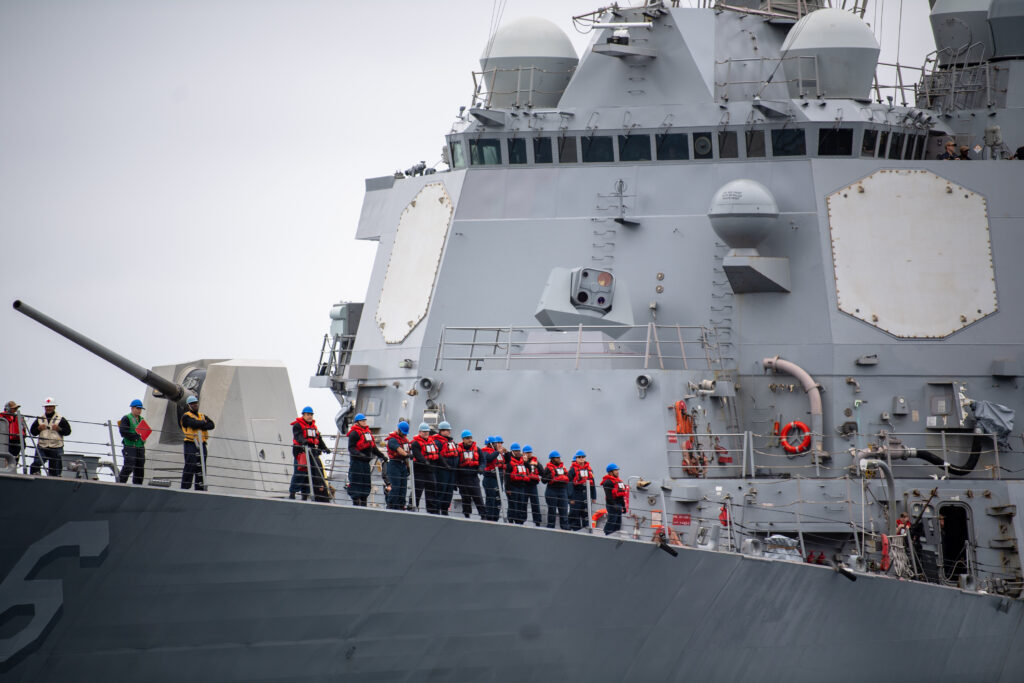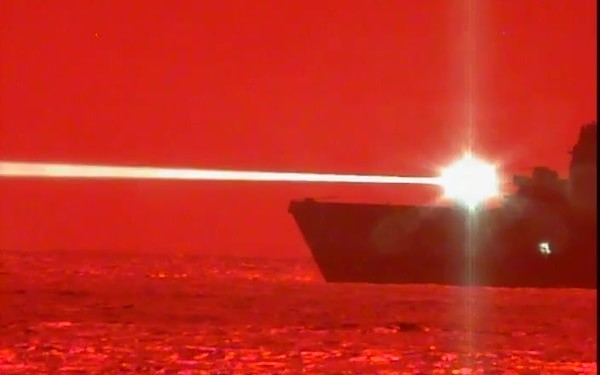
DAHLGREN, Va. — The U.S. Navy has been researching and perfecting directed energy weapons to include railguns, high-powered microwaves and lasers, along with hypervelocity projectiles — to make futuristic weapons a reality on ships today.
The Naval Surface Warfare Center Dahlgren Division in Dahlgren, Virginia, has been leading the way in creating capabilities to give warfighters a high-tech advantage at sea, to include directed energy weapons.
“We take great pride in being a hands-on research, development, test and evaluation institution, where we possess and practice the organic technical knowledge for the Department of the Navy with respect to surface warfare,” said Dale Sisson, NSWC Dahlgren Division’s technical director. “That ends up being a fairly broad ranging mission, for sure. Having the opportunity to design, develop, test and integrate warfighting systems through the confluence of a physical range infrastructure, and a digital architecture such as our digital proving ground, is fundamentally who we are.
“We’re also in the threat engineering business, which means we understand those threats well, and that knowledge translates back into understanding how to develop the weapons to counter that on a defensive standpoint, as well as create the offensive advantage that puts us ahead of the game,” said Sisson.
While the Navy’s railgun efforts are currently on hold, laser systems are installed or in the process of being integrated into ship combat systems today. In fact, much of Dahlgren’s work on railguns is being leveraged today for new capabilities such as hypervelocity projectiles.
Today, lasers are a reality in the fleet. A prototype Optical Dazzling Interdictor, Navy, or ODIN system, designed and built by Dahlgren, is being evaluated aboard the Arleigh Burke-class guided missile destroyers USS Dewey (DDG 105), and other Burke-class ships. The Lockheed Martin High-Energy Laser with Integrated Optical-dazzler and Surveillance system is being tested aboard another Burke-class ship, USS Preble (DDG 88). The Solid-State Laser Technology Maturation (SSL-TM) program is developing an integrated Laser Weapons System Demonstrator, built by Northrop Grumman, which is installed and being tested aboard landing ship dock USS Portland (LPD 21).
All of them can thank Dahlgren for vital concept development, design and testing. Dahlgren’s Laser Lethality Laboratory and Laser Firing Range have provided knowledge, expertise and experience to mature the technologies and integrate the capabilities into the combat systems on the Navy’s warships.
“Our laser firing range allows us to fire across Upper Machodoc Creek so we can examine how the maritime boundary layer between the water and the atmosphere affects laser performance. We have a two-story building within our explosive experimental area we use as a backstop for laser beams,” Sisson said. “We can shoot up to about four kilometers, depending on where we position lasers on the range from the backstop.”
Dr. Chris Lloyd, distinguished scientist for laser weapon system lethality, leads the Navy’s laser lethality efforts.
“NSWCDD has extensive experience in integration of Navy laser weapon systems, from subcomponents up to full systems. The Navy laser lethality team supports development, assessment and deployment of laser weapons and conducts rigorous testing, modeling and simulation to drive requirements for advanced laser weapon system development for the Navy. Lethality is more than simply damaging materials, but understanding how threats are going to respond. We have to understand threat response, based on the damage we inflict, and apply that data, along with weapon system parameters and propagation information to tell the complete weapon effectiveness story,” he said.
“Our industry partners team closely with the government directed energy workforce to integrate and test laser weapon systems at Dahlgren test ranges as well as other DoD test locations in the country,” said Lloyd. “If they have a system that’s ready to be tested in preparation for deployment, we can use actual system performance test data in our lethality and effectiveness analyses to validate models and assess overall lethality.”

Working Together
Lloyd said the Dahlgren team has been part of technical area working groups that have been together for the better part of 20 years, and, as a result of that, have become very proficient at working together and sharing data.
“We collaborate closely with the Army, Air Force, Missile Defense Agency and the Joint Directed Energy Transition Office,” he said. “We also work with the FFRDCs [Federally Funded Research and Development Centers] and academia to advance key S and T [science and technology] areas.”
Dahlgren’s lethality lab has several key features, including a repurposed World War II tunnel for longer range propagation studies. It’s environmentally controlled, and can introduce moisture and aerosols to see how they affect not only propagation but lethality.
“We can look at battlefield contaminants, atmospheric conditions, and understand lethality through those conditions,” said Lloyd.
“We’re in the business of putting holes in targets and damaging components. That’s the ‘target vulnerability’ piece of it,” he said. “But we’re interested in the overall weapon lethality. We have to understand the weapon system performance specifications, as well as the atmospheric conditions and the impact on overall effectiveness. We work very closely with the atmospheric community to grasp those principles and pull them into the modeling. We also collect vulnerability data on different materials all the way up to subsystem components and full systems.”
Another aspect of Dahlgren’s laser lethality efforts involves the modeling and simulation analysis team. “Fundamental properties for the materials we test against are fed into those models, along with all the basic parameters like conductivity,” said Lloyd. “It all has to be well understood.”
Sisson said the science and technology is important, but Dahlgren’s staff knows how to put that knowledge into practical systems.
“We have the technical knowledge to build a system. But that’s not enough. We have that true subject matter expertise that knows how to design, develop, deliver and field systems. When we’re working on a tactical laser system, our engineers also understand systems integration and what it takes to go acquire things. We have to be able to install and operate that system on a ship reliably and effectively,” Sisson said. “We need a system to target the beam and conduct battle damage assessment, and it has to integrate with the ship’s combat management system. We have to be able to make it fit and work on a ship in a challenging maritime environment.”
Not Just A Laser
“Dahlgren has been instrumental in the continued technology maturation for high energy lasers and the success of LWSD,” said Donna Howland, acting general manager of Northrop Grumman’s Directed Energy operating unit. “We learned from their expertise on how to operationalize high energy lasers.”
“It’s not just a laser. We want to integrate the laser — as both a sensor and weapon — as a full participant in the combat system,” said Capt. Casey Plew, NSWC Dahlgren Division’s commanding officer. “We’re building a weapon that includes the mount, power, thermal management, command and control, tracking and doctrine, all done in coordination with government, industry and academia partners.
“Lasers are a great piece of the mission we perform, but they are only one part of the complex puzzle. And the awesome women and men of NSWC Dahlgren Division have been helping to solve our surface navy warfighting puzzles — for almost 104 years. It is in our DNA. It is what we do,” said Plew.
- A Day to Remember - September 11, 2023
- Indo-Pacific Maritime Security Exchange will examine emerging capabilities and capacity - July 12, 2023
- Cold Waters Spark Warm Relationship - April 20, 2023




